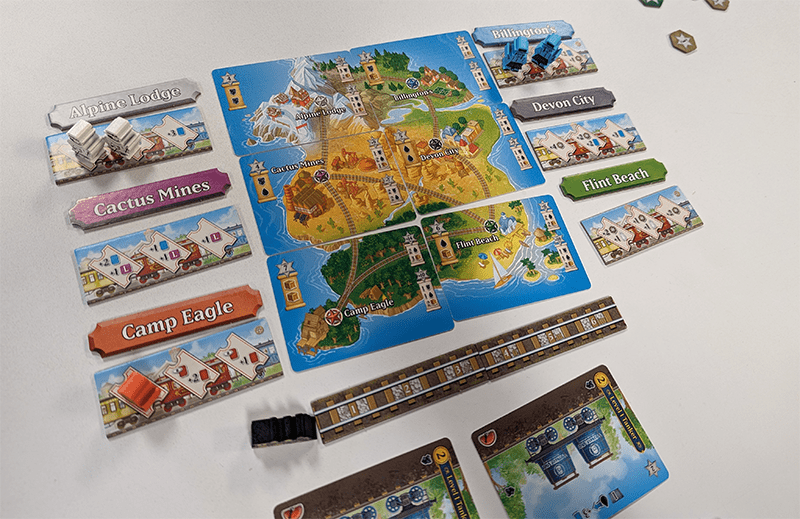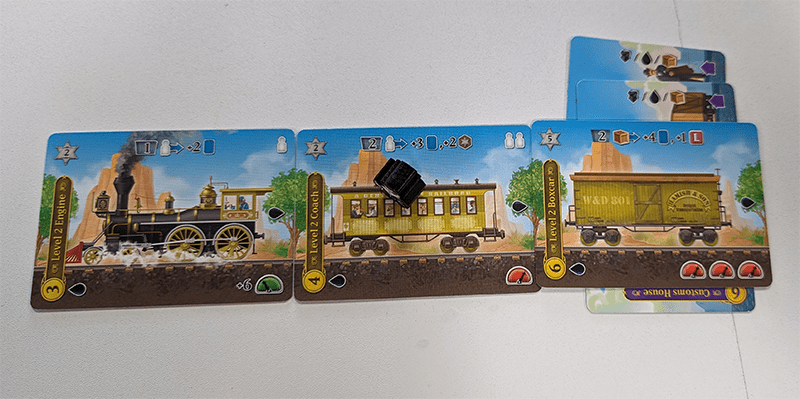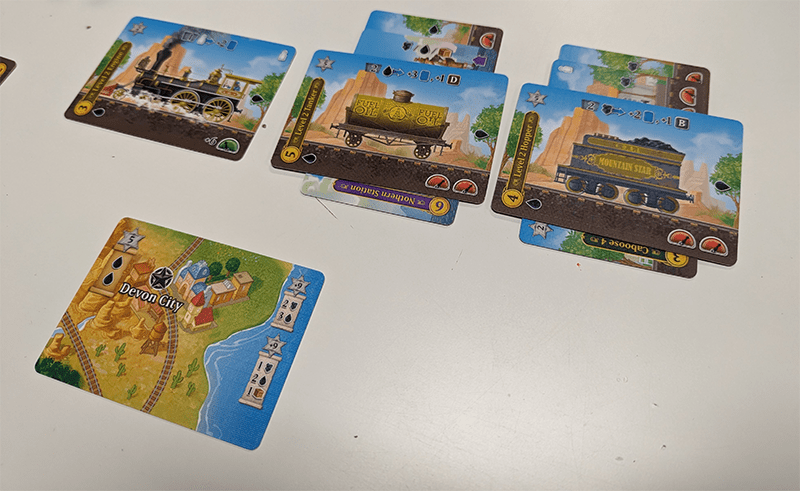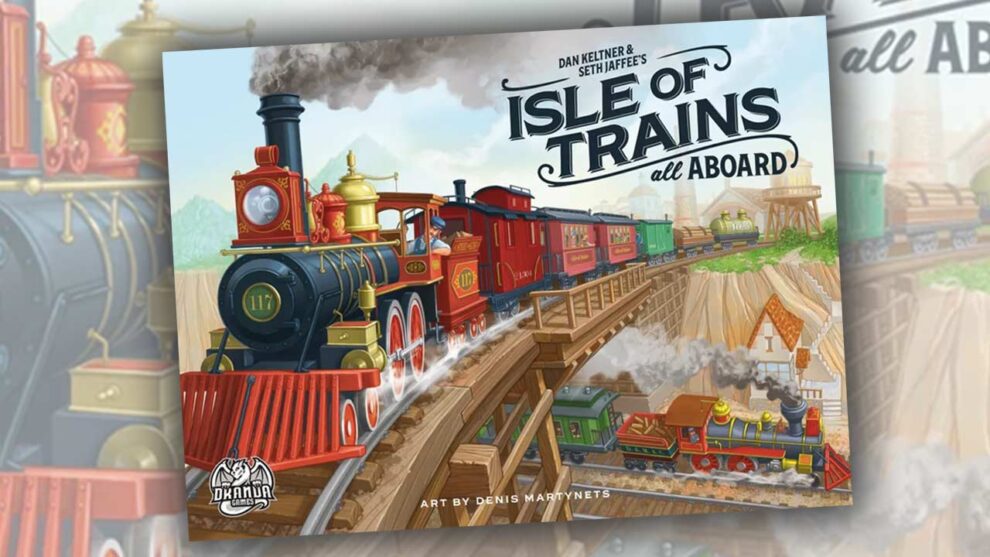Disclosure: Meeple Mountain received a free copy of this product in exchange for an honest, unbiased review. This review is not intended to be an endorsement.
Trains and board games. Peanut butter and jelly. High living costs and Canada. Me and bad jokes. For whatever divine reason, these subjects cannot be separated. What’s quite interesting about train board games is they are often associated with complexity and mind melting sessions. Here comes Isle of Trains: All Aboard to show the world that you can have some train conductor fun with a deck of cards in only an hour of your time. With a concept like this, you can see why this one wrangled more than a few pairs of eyeballs.
The story driving this one is quite barebones. There is an island where train conductors throughout the world attend a competition to see who is the best. This involves delivering passengers, fulfilling cargo contracts, and showing off your sweet ride that rewards you with victory points. Think of it as the Isle of Man TT except replace motorcycles with trains and without a body count.
Since this is a card game, it’s time I talk a bit about them. Isle of Trains: All Aboard is one of the few card games that consists almost entirely of multi-use cards. For those who don’t know the terminology, it means that cards can be used in a variety of ways, depending on the context. In Isle of Trains: All Aboard’s case, the cards can act as currency, cargo, buildings, or train cars.

Loco Motives
Now all of this is done through the game’s extremely simple turn structure. In short, you have two actions to use and you have a small menu of four different types of actions.
The Take action is used to either take a card from the face up display or deck. You also can take a passenger from the nice looking red bag and place it in front of you. The passengers are color-coded, representing the six regions on the island that they prefer to go to.
Build is nearly as easy as the Take action. You are going to build or upgrade one of your existing train cars. Like real life, there is a cost to doing this and you pay for this by discarding cards from your hand.
Load is where the game gets a bit more interesting. Players can load cargo or passengers onto their own train cars, which provides no immediate benefit. However, you also have the choice to load an opponent’s train cars. If you load an opponent’s car, you gain bonuses like drawing additional cards, doing bonus actions, or earning victory points. For example, loading a level 2 Coach car lets you draw three cards and gain one victory point, all for helping your opponent deliver a free passenger. This clever mechanism ensures the Load action goes beyond routine card plays to create interesting decisions and combos.
The last, and perhaps the most “complicated”, action is Delivery. You pick one of the six colored regions and from there, you have a variety of moves you can do. If you deliver a passenger matching the color of the region, you place that passenger on the region’s ticket tile for a variety of bonuses, such as extra actions or drawing cards. You can also discard other passengers of different colors to draw some extra cards.
But the major reason you want to do a Delivery action is to fulfill contracts through your cargo. Each region card has a primary contract and two secondary contracts. Once you complete a primary contract, you physically take the region card and put it in front of you. You cannot get another region card until you finish one of the two secondary objectives, so plan accordingly.
Caboose or Lose
In addition to the core actions, Isle of Trains: All Aboard has some extra elements. You can acquire one Building card during the game that provides an end-game bonus. Caboose cards also offer ongoing passive benefits, like allowing extra card draws after a Delivery action. An important factor is managing the weight limit of your train. Heavier train cars put more strain on your engine, requiring you to upgrade it over time to transport more goods and passengers. Let’s just say that planning when to deliver and using your limited actions wisely is going to take a lot more thought than you think.
And that right there is why I enjoy Isle of Trains: All Aboard. The box is small and doesn’t have an aggressive table presence, yet it still maintains the decision space that one would expect in a bigger game. I would even say that I prefer this far more than most of the games in the Tiny Epic series. At least the rules aren’t obnoxious to teach.
What’s more impressive is that it is practically a revolt against the traditions of these types of games. Many games that involve constructing combos and point-generating systems tend to focus on solitary optimization rather than dynamic interplay. Yet the Load action adds a fascinating player-vs-player element, forcing you to engage in an interesting risk-reward scenario. You must weigh providing a small advantage to an opponent against the immediate benefits you’ll receive.

Rail Fanning
Isle of Trains: All Aboard is also surprisingly cutthroat, despite its friendly appearance. There are six regions, seven if you play with a four player count, and claiming one of those regions denies everyone else the privilege of filling those contracts. While that sounds quite unforgiving, it can also hurt you. If you cannot satisfy that secondary contract, you are locked in for the rest of the game to get more island cards and, most importantly, more points. I’ve seen plenty of my players get irate when they realize they cannot complete their secondary contract. In fact, I would say I’ve seen it too much.
One criterion I always evaluate in a board game is the amount of enjoyment one would get, even if they are losing terribly. Good games are fun to lose. There is a reason why I am bringing up this point in this review. If you are losing a game of Isle of Trains: All Aboard, with its short game length and light complexity, it is one of the most painful experiences in tabletop gaming. It is absolute distilled pain poured into a row of half a dozen shot glasses with no can of coke in sight to dilute the taste.
Wrong Track
When the game is at its highest of highs, it’s euphoric. You have so many options to examine, calculate, and consider. The energy emanating from this scenario is much like a dog rooting through a trash can, ready to have their taste buds go off to new adventures.
On the other side of that extreme, the game becomes a nauseating experience if things aren’t going your way. Your choices are limited and predictable. The downtime is like the sun to your candle, as you know your turn will only be mere seconds yet you are waiting for everyone else. What’s worse is that not only is your turn boring, but it’s also unproductive.
Ironically, the source of these frustrations is also the game’s biggest strengths. Double-edged sword and all that.
Let’s go back to the Load action. In four player games, you are competing with two other opponents to have your train loaded with cargo and passengers. If your train is not generating the same benefits as your opponents, you will be ignored. You cannot utilize the free cargo or passengers, thus forcing you down a linear, anticipated path. At three players, this is less of an issue. Two player sessions are where this entire system truly stands out, like a lit torch in a pitch-black cave.

Off The Rails
Even the game’s love for quick pace can sometimes harm the experience. You need to start building your train as soon as possible to grab those regions and get that combination engine running at full steam. If you take too long to build your giant metal train contraption, your opponents will snatch up everything. What’s the best move? Deal with your starting hand and move on. As for those secondary contracts, you need to upgrade your Train engine so if you can’t draw it or afford it, tough luck.
I really want to love Isle of Trains: All Aboard because it contains elements I look for in a great card game. The multi-use cards, interactive player dynamics, and potential for clever combos are all appealing. On paper, this seems like a game I would eagerly embrace. Yet, despite its strengths, it falls a bit short for me due to some limitations.
The downtime can drag with higher player counts, and the gameplay can feel punishing at times. It works much better as a fast-paced duel at two players, or a slightly broader experience at 3 players. It loses steam at four when turns take too long. With some tweaks, it could really shine with far more consistent gameplay. Ultimately, while Isle of Trains: All Aboard doesn’t rank among my favorite games, it gets more right than wrong.











Add Comment